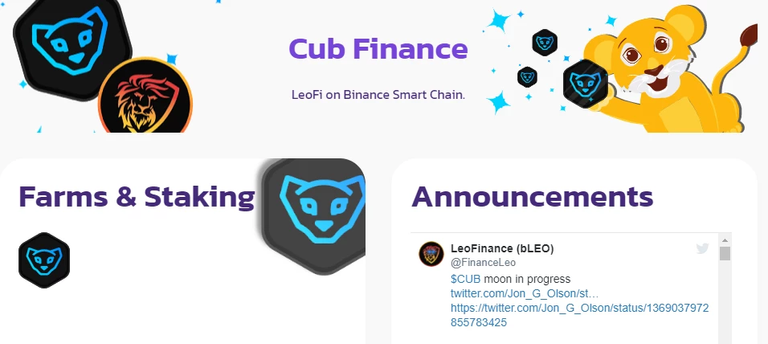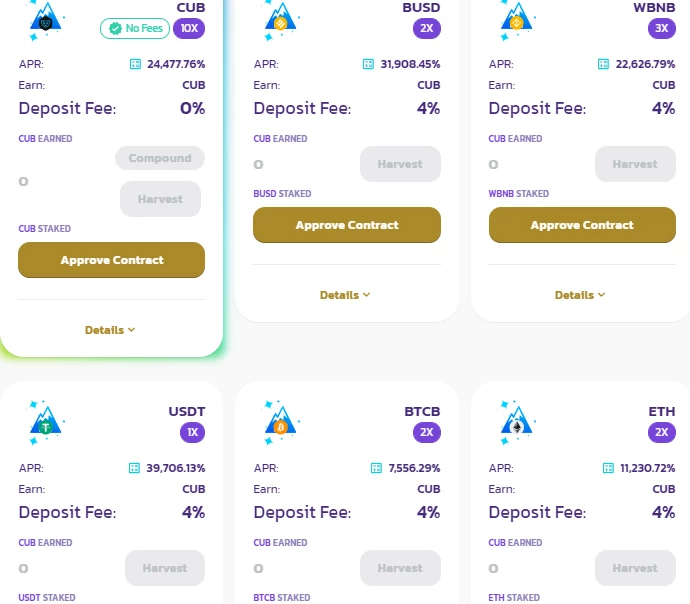
In my last article here, I explained the top things to note about LeoFinance. Now in this article, I will describe the top things you should note about CubFinance (or CubDeFi)
CubFinance is an extension of LeoFinance in that it was built by the same person and can be used in conjunction with Leofinance.
CubFinance is a full blown DeFi platform and exchange offering quick and nearly instant swaps, a bridge to swap from BSC to ERC-20 and (coming soon) an automatic yield optimiser.
Let's take a look at what I'll be discussing in this article:
- What is CubFinance?
- Who created CubFinance?
- What is CUB?
- How can you earn CUB?
- Where and how can you buy CUB?
- Where can you store CUB?
- What is the LeoBridge?
- What are dens?
- What are kingdoms?
Let's get started!
What is CubFinance?
CubFinance is a decentralised exchange and DeFi as a service (DAAS) platform allowing users to not only seamlessly and almost instantly swap between assets, but also farm and stake their tokens to earn even more tokens. The platform has some features, some which are proposed and some which are already implemented. We will discuss these features later on.
CubFinance is a "friendlier" approach to the decentralised exchange scene offering cleaner and softer designs and a lot of cartoon representations.
Who created CubFinance?
CubFinance was created by the same person who created LeoFinance. CubFinance was created by Khaleel Khazi, a rather prolific startup builder who has been responsible for a few startups to this point.
What is CUB?
CUB is the native token of the CubFinance exchange and serves as a means of payment of some of the platform's fees. These fees include:
- Bridge fees
- Kingdom fees
It is at the moment unclear if CUB will be used for governance (or if governance is coming to the CubFinance platform), but for now, it is the main token of the exchange.
How can you earn CUB?
CUB can be earned through a bunch of ways:
- Staking your LP in LP pools to yield CUB as a reward.
- Staking your CUB in the dens to give even more cUB.
(Side note: The thing I like most about the platform is the ability to use your CUB to earn even more CUB, which is sweet!)
Where and how can you buy CUB?
Currently, there is no exchange where CUB can be bought with fiat, however, you can buy BNB with fiat, and swap that BNB to CUB on the CubFinance platform. Hopefully cUB will be listed on tier-1 exchanges soon so that we can use fiat to buy it.
Where can you store CUB?
CUB is a token on the Binance smart chain, so any wallet supporting BSC can be used to store CUB, including Trust wallet, Math wallet, Guarda and Atomic wallet. Binance's own SafePal wallet can also be used to store your CUB.
If there is any trouble or you can't find CUB in the drop down menu, simply go to the "Add token" section of the wallet and input this contract address: 0x50d809c74e0b8e49e7b4c65bb3109abe3ff4c1c1. CUB will instantly be added to the wallet view and you will be able to see your tokens.
What is the LEO Bridge?
I have a more in-depth article on what LeoBridge is here, but in short: It is a smart contract that will allow a user to change a token on the Binance Smart Chain into a copy of itself on the Ethereum chain. I explained all its pros and cons in that article, so in order to keep this one short, i will not re-explain here. You can read that article if you need more info.
What are dens?

(forgive the old screenshot. For some reason I couldn't upload the new one i took)
Dens are simply staking pools! You simply take the asset of the den, approve the contract and add the tokens into the pool. Then you begin to accrue more tokens of the pool you staked in.
For instance, if I stake in the CUB pool, I will earn more CUB. Staking in the WBNB pool will allow me to earn more WBNB, and so on. Simple as that!
What are kingdoms?
Again, I have made an article more detailed than this explaining what kingdoms are. You can check it out here for an even more in-depth look at kingdoms.
In short, kingdoms are auto yield optimisers. They essentially compound your investment for you. Say you invest 1000BNB and earn 10BNB everyday. A non-optimiser will keep adding your new day's profits to your current profits and will leave it at that. An optimiser however will re-invest your capital and profit everyday, so you begin to see very huge gains overtime.
You can read my linked article for more info!
That's my article guys! Did I miss anything? What do you think of CubFinance? Let's talk in the comments!
If you enjoyed this article, consider following me and pressing the heart on the bottom of the page. It's REALLY encouraging.
Thanks for reading, and I'll see you next time!
Posted Using LeoFinance Beta